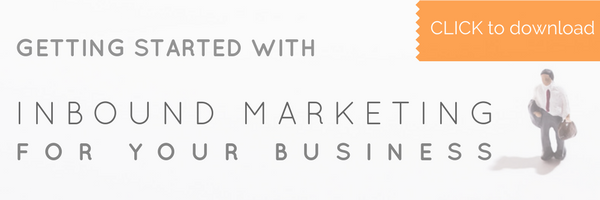
Who your website visitors are depends on where they are mentally
Marketing isn't about creating the best possible message, then broadcasting it to the widest possible audience to try and snare as much attention as possible at the quickest possible rate - at least, not for me. Not for inbound. Not for business owners that want more from their marketing than impressive looking reports.
It creates too much noise... attracts too much rif-raff... and, quite frankly, it opens the doors for way too many bad choices. It's also a huge turn-off to good prospects.
No, I like helping businesses focus on the individual who is more likely to buy from them at some point, so when I or any of my colleauges here at Orange Pegs develop a blog post, email, landing page, content download, or website page, we are gearing that content for them.
In the past, I've talked about buyer personas, and even had my agency put together a download to make it easy for you to create and manage your own (click HERE for the download, and HERE for the article).
But personas are only part of the equation. WHERE they are in their "buyer decision process," or "buyer's journey," is the other part.
The 3 phases of the Buyer Decision Process
Each phase of the buyer's journey offers unique challenges and opportunities for us marketers, and they represent distinctly different stages of consciousness when it comes to your products or services.
You wouldn't treat CEOs the same way you'd treat HR Managers or Operations in the way your company delivers its services, so you shouldn't market to them the same way either. I think most people understand that concept to a degree, but the challenges are in how to separate them in execution...
In the same sense, your website shouldn't treat visitors or leads who are just learning about their problems the same way as those who know the types of solutions they need. We don't lead with proposals, right?
Of course not, but if people can only convert into leads on your website by filling out the "contact us now" form or by calling in and requesting a consultation, you're only making it easy for those who are ready to buy, and forgoing all other attention where maybe they still just need to be educated and go through their own personal buyer decision process.
This is why most websites underperform, or don't perform at all.
(learn more about Orange Pegs Media's website design services)
Phase 1: Awareness
The Awareness stage is when your visitors know they have a problem, but they're not really sure what the root of it is, and they especially don't know what kind of corrective action they want to take.
This is your biggest group, because they're still at the top of the sales funnel, and haven't really been qualified out yet. Not everybody who diagnoses their issues are going to resolve them through your products or services for one. After all, there is a qualifying process, and not everybody who visits your website will make for a good customer.
We have to expect that.
Again, it's your biggest group out there, so we don't want to ignore it, and if you can root out those with real opportunity early in the process, yours will be the first company they look to when they are ready to take it to the next level.
This is an important stage that a lot of businesses tap into in some sense or another, but often miss capturing, because of their limited conversion mechanisms.
We know that education is important in getting prospective customers to listen to your sales teams' pitches, so there is usually no shortage of educational content on the websites I review. However, the nature of that educational content tends to be focused on solutions, not the actual problems. And remember, those diagnosing don't know what solutions make sense for them, because they don't fully understand their issues yet, and we don't want to pitch until we know we should be pitching.
MORE LIKE THIS: How to Leverage Website Development Costs into Quantifiable Sales
For example, does your website focus on your company or your customers? Really think about this, because traditional website design focuses on the businesses they represent, not the problems their visitors are experiencing.
Here's a test for you:
- What does your menu say about your customers? Next to "home" does it provide information that is useful to them, or is it about your company (mission, about us, history, etc)?
- What about your opening paragraph on your home page? Do you have one? If so, who does it talk about? Your business or your customers?
- What do the images say about your customers?
- What is the purpose of your blog, and who gets value out of it? Do you post exciting news about your company, or do you offer advice and educational content to your visitors?
- And what about your CTAs (call-to-actions)? Do they all point to the same "contact us" form, or do they lead to more content that educates without selling?
It's not very common for websites to communicate the way your visitors want to be communicated with, especially, in my experience, with staffing agencies, CPA firms, e-commerce, and other b2b services. SaaS tends to be hit or miss, depending on how in tune you are with your customer's level of understanding of your jargon. But it's mostly very difficult for visitors to see why they would want to continue exploring unless they were specifically sent there by somebody from your company.
In all of my years in sales prior to starting this agency, I could never use the websites my employers had for anything more than a backstop to very specific information. They certainly didn't get anybody calling in except for the occasional tire-kicker, and there were no avenues for conversion except for those who were supposedly ready to have serious conversations about buying.
But awareness should be about discovery, and like the other two phases of the buyer's journey, it should find its way into every nook and cranny of your marketing strategy - from blog posts to the content on your site... even your follow-up emails and social media posts. This comes down to language and the paths for conversion.
Now, I'm going to share some examples of how to reach visitors using inbound marketing at the various stages, starting with awareness.
Examples of Awareness-stage content downloads from Orange Pegs:
Examples of Awareness-stage articles:
- So, You Want a New Website for Your Business?
- How to Grow Your Business: Lessons from a 2 Year Old
- 7 Hard Truths about Social Media Marketing
- Modern Marketing Solutions for 3 Common Sales Problems
- Growth Driven Design Will Make Your Website Better at Making You Money
Examples of Awareness-stage website pages:
Phase 2: Consideration
At the consideration stage, your visitors already know what ails them, and are now exploring viable solutions. Not everybody who goes through the awareness stage will end up here, and you'll also get people who start here with you. I often find that many who start here are actually putting the cart before the horse, and don't even know why they're here to begin with, which means we're still in the awareness stage.
It's important to be able to recognize when that is the case, particularly on those sales calls, but that can be handled by asking simple questions about why they're there, and what they hope to get out of connecting with you. (learn more about our sales enablement services)
At this stage, you're still educating, but your tone and focus change. Instead of helping them diagnose their problems, you're helping them find viable options to problems they know the root cause of. The group here is smaller than at the awareness stage, and they mostly understand why they're there... mostly
Examples of Consideration Stage Downloads:
Examples of Consideration stage articles:
- Why Hubspot Might Very Well Be the Best Blogging Platform Out There
- How to Calculate ROI for Your Marketing Efforts
Examples of Consideration stage pages:
Phase 3: Decision
These are the folks who are looking for a reason to buy from you. They may start the conversation requesting a proposal (although that's not a dead-giveaway, because I've had plenty of people still in the awareness stage ask for a proposal, so they could see what our plan was and what we offered, and use that to educate themselves), but I never get it to them until we know for certain they are qualified, engaged, and ready to make a decision.
You're going to do better at this stage if you ushered your leads in from one of the other two, because you won't have to undo the often misguided expectations set by other websites or sales reps.
Don't be afraid to push them back into awareness or consideration if you get the sense that they don't understand the full scope of what you can do for them.
As far as your marketing is concerned, we still want to capture these folks and get them to convert to leads and customers, so we must write for them as well. At this stage, there are certain things you want delivered directly by your sales people.
Examples of Decision-making stage downloads or offers sent directly from sales:
- Start-up Case study
- Side-by-side services comparisons
- Proposals
- Marketing ROI calculator (yes, this shows up in consideration AND decision depending on how it's positioned)
Examples of Decision-making articles:
- What to Expect When You Ask For a Marketing Proposal
- Testimonials
Examples of Decision-making stage pages:
CONCLUSION:
The marketing industry is going through a change. Content is becoming the norm, because Google and its brethren want it that way. Bill Gates predicted it would be this way over 20 years ago when he wrote the essay, "Content is King," and he was right on the money.
The internet has changed the way we buy. It has empowered us to make more informed decisions, and to discover them at our own pace. Inbound marketing and growth-driven design cater to those exact notions. We don't impose, we educate. We attract. We make it easy for visitors to understand our mission without talking about our mission, but rather, by talking about them.
Download the guide to getting started with inbound HERE:


